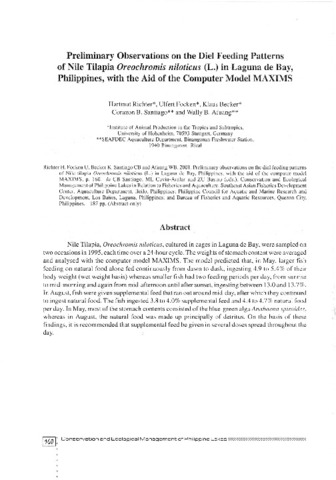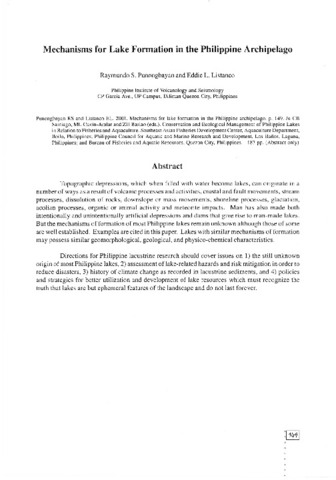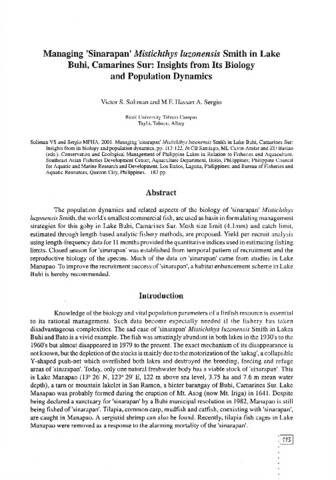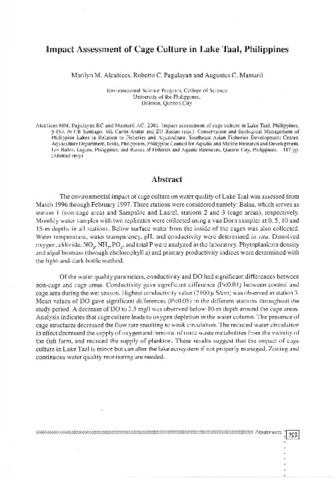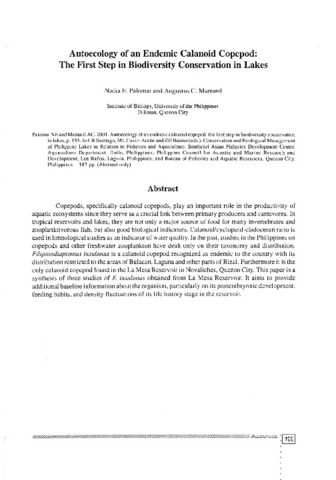Browsing Conservation and Ecological Management of Philippine Lakes in Relation to Fisheries and Aquaculture by Issue Date
Now showing items 21-27 of 27
-
Preliminary observations on the diel feeding patterns of Nile tilapia Oreochromis niloticus (L.) in Laguna de Bay, Philippines, with the aid of the computer model MAXIMS
(Aquaculture Department, Southeast Asian Fisheries Development Center; Philippine Council for Aquatic and Marine Research and Development (PCAMRD), Department of Science and Technology; Bureau of Fisheries and Aquatic Resources, 2001)Nile Tilapia, Oreochromis niloticus, cultured in cages in Laguna de Bay, were sampled on two occasions in 1995, each time over a 24-hour cycle. The weights of stomach content were averaged and analysed with the computer ... -
Mechanisms for lake formation in the Philippine archipelago
(Aquaculture Department, Southeast Asian Fisheries Development Center; Philippine Council for Aquatic and Marine Research and Development (PCAMRD), Department of Science and Technology; Bureau of Fisheries and Aquatic Resources, 2001)Topographic depressions, which when filled with water become lakes, can originate in a number of ways as a result of volcanic processes and activities, crustal and fault movements, stream processes, dissolution of rocks, ... -
Lake Lanao: Its past and present status
(Aquaculture Department, Southeast Asian Fisheries Development Center; Philippine Council for Aquatic and Marine Research and Development (PCAMRD), Department of Science and Technology; Bureau of Fisheries and Aquatic Resources, 2001)Geographically located in Central Mindanao, Lake Lanao is the second largest lake in the Philippines. The lake is famous locally for its various uses and internationally for its endemic cyprinids. This paper intends to ... -
Managing 'sinirapan' Mistichthys luzonensis Smith in Lake Buhi, Camarines Sur: Insights from its biology and population dynamics
(Aquaculture Department, Southeast Asian Fisheries Development Center; Philippine Council for Aquatic and Marine Research and Development (PCAMRD), Department of Science and Technology; Bureau of Fisheries and Aquatic Resources, 2001)The population dynamics and related aspects of the biology of 'sinarapan' Mistichthys luzonensis Smith, the world's smallest commercial fish, are used as basis in formulating management strategies for this goby in Lake ... -
Aquaculture practices and their impact on Philippine Lakes
(Aquaculture Department, Southeast Asian Fisheries Development Center; Philippine Council for Aquatic and Marine Research and Development (PCAMRD), Department of Science and Technology; Bureau of Fisheries and Aquatic Resources, 2001)The rapid progress and development in the aquaculture sector during the past years has made an important contribution to the overall fish production in the Philippines. In 1996, 35.4% of the total fish production or 980,857 ... -
Impact assessment of cage culture in Lake Taal, Philippines
(Aquaculture Department, Southeast Asian Fisheries Development Center; Philippine Council for Aquatic and Marine Research and Development (PCAMRD), Department of Science and Technology; Bureau of Fisheries and Aquatic Resources, 2001)The environmental impact of cage culture on water quality of Lake Taal was assessed from March 1996 through February 1997. Three stations were considered namely: Balas, which serves as station 1 (non-cage area) and Sampaloc ... -
Autoecology of an endemic calanoid copepod: The first step in biodiversity conservation in Lakes
(Aquaculture Department, Southeast Asian Fisheries Development Center; Philippine Council for Aquatic and Marine Research and Development (PCAMRD), Department of Science and Technology; Bureau of Fisheries and Aquatic Resources, 2001)Copepods, specifically calanoid copepods, play an important role in the productivity of aquatic ecosystems since they serve as a crucial link between primary producers and carnivores. In tropical reservoirs and lakes, they ...

